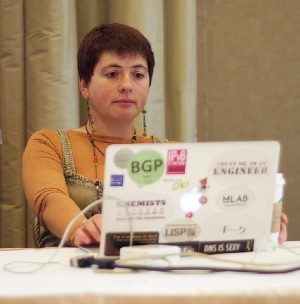 Today’s third day of IETF 92 turns out to be a quieter one for the topics we cover here on Deploy360. The big activity will be in the first of two IPv6 Operations (v6OPS) working group sessions. There will also be a reboot of the SUNSET4 working group and what should be an interesting discussion about “route leaks” in the GROW working group. Here’s what our day looks like…
Today’s third day of IETF 92 turns out to be a quieter one for the topics we cover here on Deploy360. The big activity will be in the first of two IPv6 Operations (v6OPS) working group sessions. There will also be a reboot of the SUNSET4 working group and what should be an interesting discussion about “route leaks” in the GROW working group. Here’s what our day looks like…
NOTE: If you are unable to attend IETF 92 in person, there are multiple ways to participate remotely.
In the 0900-1130 CDT block this morning, we’re not actively tracking any of the listed working groups as they don’t tie directly into our Deploy360 topics. However the BESS session about BGP-enabled services could be interesting, as could the SPUD BOF looking at what are barriers to implementing new transport protocols on the Internet (more info in the SPUD overview presentation).
After lunch from 1300-1500 CDT in the International Room will be the first of two IPv6 Operations (v6OPS) sessions (the second being tomorrow) with a packed agenda looking at design choices for IPv6 networks, IPv6 deployment case studies / lessons learned and more. As IPv6 deployment continues to grow month over month, incorporating feedback from that deployment process back into the standards process is an essential part of ensuring continued growth.
In the 1520-1620 CDT block over in the Gold Room, the IPv6 discussion will continue in the SUNSET4 working group that is chartered to document and explore how well things will work in an IPv6-only environment when IPv4 is no longer available (i.e. IPv4 has “sunsetted”). As noted in the SUNSET4 agenda, the working group has had a loss of momentum and will be looking today at how to restart efforts to move work items along.
Simultaneously over in the Parisian Room the Global Routing Operations (GROW) working group will be looking at how to improve the operations of the Internet’s global routing infrastructure. As my colleague Andrei Robachevsky wrote in his Rough Guide to IETF 92 post:
In general, the focus of the GROW WG is on operational problems associated with the global routing system, such as routing table growth, the effects of interactions between interior and exterior routing protocols, and the effect of operational policies and practices on the global routing system, its security and resilience.
One of these items, which originally emerged in the SIDR WG and is now being discussed in the GROW WG, is so-called “route-leaks.” Simply speaking, this describes a violation of “valley-free” routing when, for example, a multi-homed customer “leaks” an announcement from one upstream provider to another one. Since usually customer announcements have the highest priority, if no precautions are taken this results in traffic from one provider to another bypassing the customer – potential for a staged MITM attack. But this is an explanation in layman terms, and the group was working on nailing down the definition and the problem statement, see https://datatracker.ietf.org/doc/draft-ietf-grow-route-leak-problem-definition/.
This issue of “route leaks” is one that comes up repeatedly and is causing problems on the global Internet. For instance, yesterday DynResearch tweeted about a route hijack of Google’s site by Belarus Telecom – now I don’t know if that was an actual “route leak”, but it’s the kind of routing issue we do see often on the Internet… which is why this class of issues needs to be identified and solutions proposed.
And just because we really want to be in three places at once… over in the Venetian Room during this same 1520-1620 time block will be the “Automated Certificate Management Environment (ACME)” BOF looking at ways to automate management of TLS certificates. As the agenda indicates, the session is primarily about discussing draft-barnes-acme and the efforts being undertaken as part of the Let’s Encrypt initiative. The ideas are intriguing and proposals that help automate the security of the Internet can certainly help reduce the friction for regular users.
After all of that is over we’ll be joining in for the Operations and Administrative Plenary from 1640-1910 CDT. You can view a live video stream of the plenary at http://www.ietf.org/live/ And then… we’ll be getting ready for Day 4…
For some more background, please read these Rough Guide posts from Andrei, Phil and I:
- IETF 92: DNSSEC, DANE and DNS Security
- IETF 92: All About IPv6
- IETF 92: Routing Resilience and Security
Relevant Working Groups:
- v6ops (IPv6 Operations) WG
Wednesday, 25 March 1300-1500 CDT, International
Agenda: https://datatracker.ietf.org/meeting/92/agenda/v6ops/
Documents: https://datatracker.ietf.org/wg/v6ops/documents/
Charter: https://datatracker.ietf.org/wg/v6ops/charter/
- sunset4 (Sunsetting IPv4) WG
Wednesday, 25 March, 1520-1620 CDT, Gold
Agenda: https://datatracker.ietf.org/meeting/92/agenda/sunset4/
Documents: https://datatracker.ietf.org/wg/sunset4/documents/
Charter: https://datatracker.ietf.org/wg/sunset4/charter/
- GROW (Global Routing Operations) WG
Wednesday, 25 March, 1520-1620 CDT, Parisian
Agenda: https://datatracker.ietf.org/meeting/92/agenda/grow/
Documents: https://datatracker.ietf.org/wg/grow/documents/
Charter: https://datatracker.ietf.org/wg/grow/charter/
- acme (Automated Certificate Management Environment ) BOF
Wednesday, 25 March, 1520-1620 CDT, Venetian
Agenda: https://datatracker.ietf.org/meeting/92/agenda/acme/
Documents: https://tools.ietf.org/html/draft-barnes-acme-01
For more background on what is happening at IETF 92, please see our “Rough Guide to IETF 92″ posts on the ITM blog:
- Rough Guide to IETF 92: Welcome to Texas, Y’all!
- Routing Resilience and Security
- Scalability & Performance
- IPv6
- DNSSEC, DANE, and DNS Security
- Trust, Identity, and Privacy
- Strengthening the Internet
If you are at IETF 92 in Dallas, please do feel free to say hello to our Chris Grundemann. And if you want to get started with IPv6, DNSSEC or one of our other topics, please visit our “Start Here” page to find resources appropriate to your type of organization.
Image: a photo by Olaf Kolkman of Jen Linkova at IETF 92. Part of a larger set of IETF 92 photos Olaf has published.
